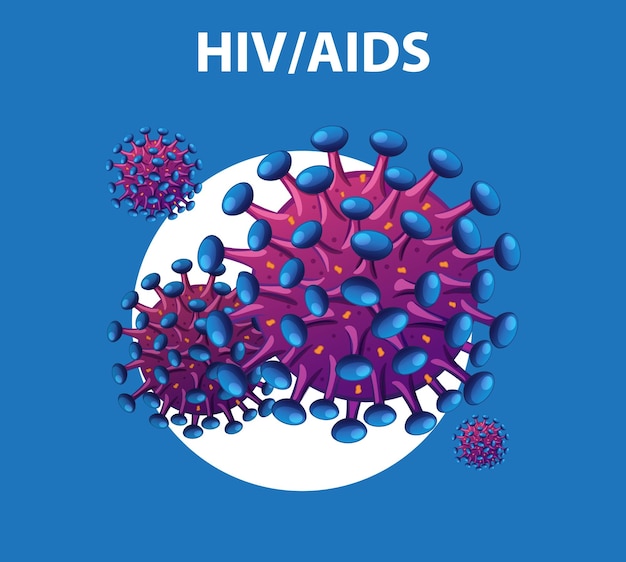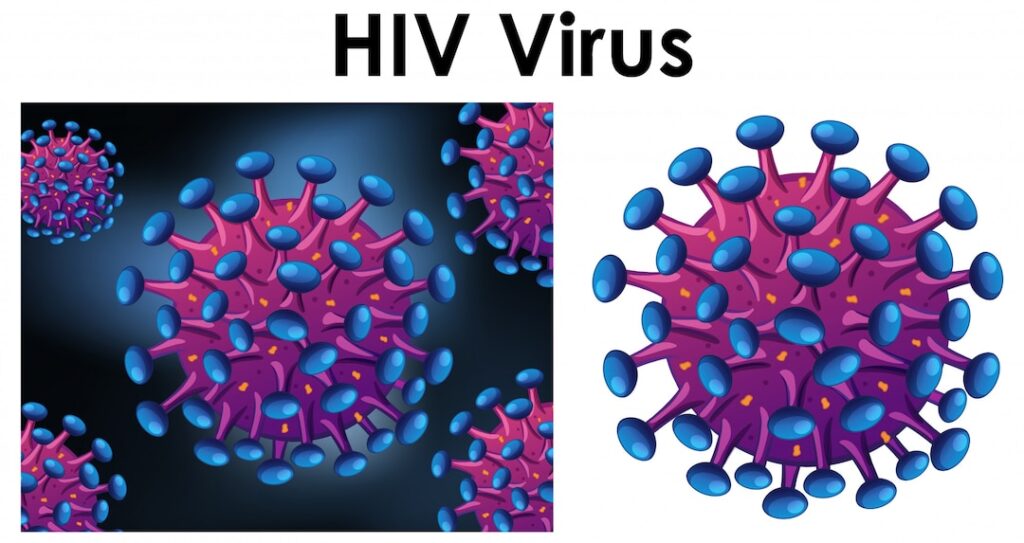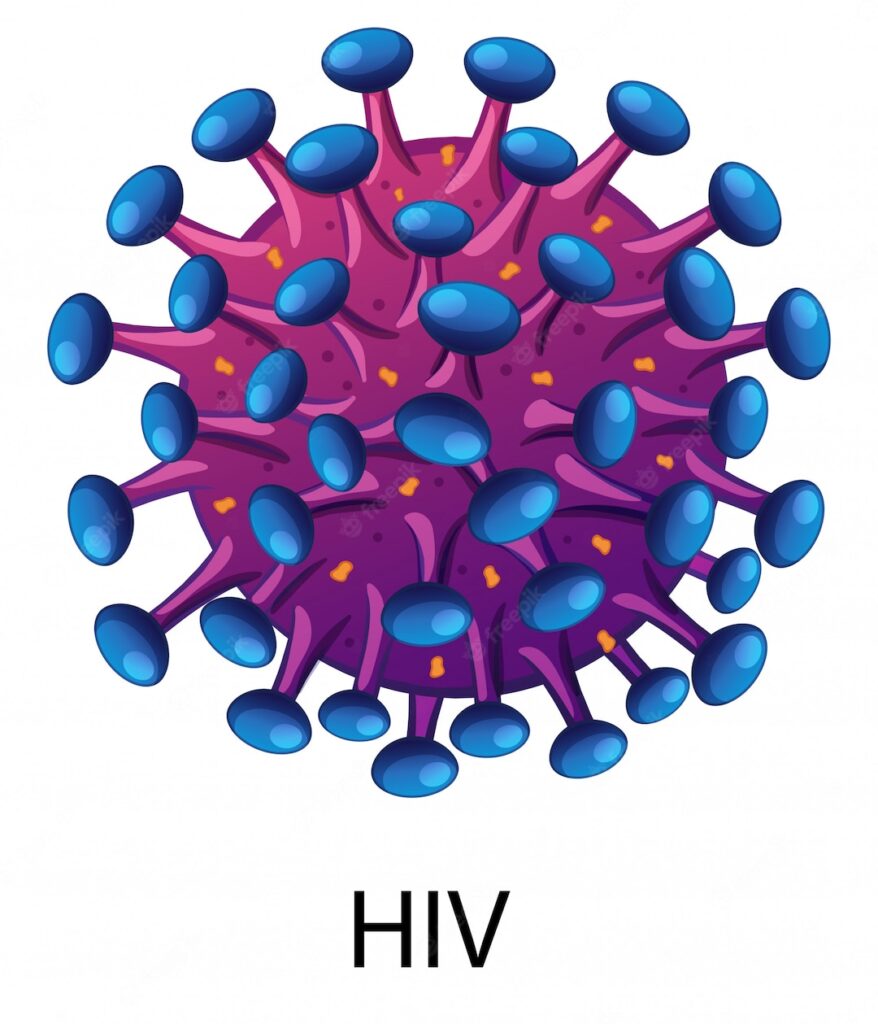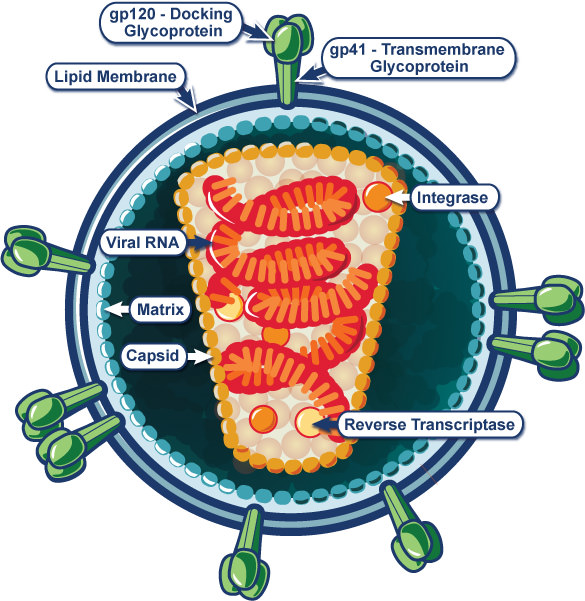Introduction

HIV/AIDS remains a global health concern that has affected millions of lives worldwide. This article delves into the causes, symptoms, prevention, and treatment of HIV/AIDS, shedding light on this complex medical condition that has garnered significant attention over the decades.
What is HIV/AIDS?

HIV(AIDS), which stands for Human Immunodeficiency Virus, is a virus that attacks the body’s immune system.
If left untreated, it can lead to Acquired Immunodeficiency Syndrome HIV (AIDS), a condition in which the immune system becomes severely compromised, leaving the body vulnerable to various infections and diseases.
Causes of HIV/AIDS.
HIV is primarily transmitted through the exchange of certain body fluids such as blood, semen, vaginal fluids, rectal fluids, and breast milk.
Unprotected sexual intercourse, sharing needles for drug use, and from mother to child during childbirth or breastfeeding are common modes of transmission.
It’s important to note that HIV is not spread through casual contact like hugging, shaking hands, or sharing utensils. https://lovishweb.com/
Symptoms and Stages
HIV infection progresses in three stages:

Acute Infection:
Shortly after contracting HIV, some individuals experience flu-like symptoms such as fever, fatigue, and swollen glands. However, many people do not show any symptoms during this stage.
Clinical Latency:
This stage, often referred to as the asymptomatic stage, can last for years. The virus replicates at a much slower rate, and individuals might not experience any significant symptoms.
AIDS:
Without proper medical intervention, HIV weakens the immune system to a point where it can no longer fight off opportunistic infections and diseases.
Symptoms of AIDS include rapid weight loss, recurring fever, extreme tiredness, and prolonged swelling of lymph nodes.
Prevention of HIV/AIDS
Preventing HIV/AIDS is crucial, and several measures can be taken:
Safe Sexual Practices:
Practicing safe sex by using condoms consistently and correctly can significantly reduce the risk of transmission.
Needle Exchange Programs:
For individuals who inject drugs, using clean needles and participating in needle exchange programs can lower the risk of infection.
Pre-Exposure Prophylaxis (PrEP):
PrEP involves taking a daily medication that can prevent HIV transmission in individuals at high risk.
Education:
Spreading awareness and educating people about the modes of transmission and prevention strategies is essential.
HIV(AIDS) Treatment and Management

While there is no cure for HIV/AIDS, advancements in medical science have led to highly effective antiretroviral therapy (ART).
ART helps suppress the virus, allowing the immune system to recover and preventing the progression to AIDS.
Early diagnosis and prompt initiation of treatment are crucial for its effectiveness.
Addressing Stigma and Discrimination

People living with HIV/AIDS often face social stigma and discrimination. It’s important to remember that HIV/AIDS can affect anyone, regardless of their background.
Advocating for understanding, compassion, and equal treatment is essential in reducing the stigma associated with the condition.
Pricuations Of HIV(AIDS)
Regular Testing:
Getting tested for HIV is an important step in knowing your status.
Regular testing is recommended, especially if you engage in high-risk behaviors. Knowing your status allows you to take appropriate steps to protect yourself and others.
Limiting the Number of Sexual Partners:
Engaging in sexual activities with multiple partners can increase the risk of HIV transmission.
Limiting your sexual partners and having open conversations about sexual health with your partner(s) can help reduce the risk.
Avoid Sharing Needles or Syringes:
If you inject drugs, it’s critical to never share needles, syringes, or any drug paraphernalia. Needle exchange programs provide clean equipment and can help reduce the risk of HIV transmission among injection drug users.
Use of PrEP and PEP:
Pre-Exposure Prophylaxis (PrEP) involves taking a daily medication to prevent HIV transmission.
If you’re at high risk of contracting HIV, such as having a partner with HIV or engaging in unprotected sex, PrEP can offer an additional layer of protection.
Post-Exposure Prophylaxis (PEP) is a treatment that can be taken within 72 hours after a potential exposure to HIV to prevent infection.
Regular Medical Check-ups:
If you’re living with HIV/AIDS, regular medical check-ups and adherence to your prescribed treatment plan are crucial.
Monitoring your viral load and CD4 cell count helps healthcare providers ensure that your treatment is effective and make adjustments if needed.
Educate Yourself and Others:
Knowledge is a powerful tool in preventing HIV/AIDS. Educate yourself about the virus, its transmission modes, and preventive measures.
Share this information with friends, family, and peers to raise awareness and dispel misconceptions.
Safe Blood Transfusions:
In healthcare settings, ensure that proper precautions are taken to avoid the transmission of HIV through blood transfusions.
Blood screening processes are designed to minimize this risk.
Protective Measures during Pregnancy:
If you’re pregnant and living with HIV, it’s important to seek medical care to reduce the risk of transmitting the virus to your baby.
Through proper medical care and treatment, the risk of mother-to-child transmission can be significantly reduced.
Circumcision:
Studies have shown that male circumcision can reduce the risk of heterosexual transmission of HIV.
However, it’s important to note that circumcision alone is not a foolproof method of prevention, and other preventive measures should still be taken.
Support and Counseling:
If you’re at risk of contracting HIV or if you’re living with the virus, seeking emotional support and counseling can be beneficial.
Dealing with the fear, stigma, and psychological impact of HIV/AIDS is an important aspect of overall well-being.
Remember that HIV/AIDS education and prevention strategies continue to evolve with advancements in medical research.
Staying informed and up-to-date on the latest recommendations is crucial for effectively preventing the transmission of the virus.
If you have specific concerns or questions, it’s always advisable to consult a healthcare professional who can provide personalized guidance based on your individual circumstances.
Viral Lifecycle and Replication:
HIV is a retrovirus, which means it uses an enzyme called reverse transcriptase to convert its RNA into DNA once it enters a host cell.
The viral DNA is then integrated into the host cell’s genome using an enzyme called integrase.
This integrated DNA can remain dormant or produce new viral particles, which eventually burst out of the host cell and infect other cells.
This cycle of replication contributes to the gradual weakening of the immune system over time.
HIV Subtypes and Strains:
HIV is classified into two main types: HIV-1 and HIV-2. HIV-1 is more common worldwide and has several subtypes (known as clades) that are prevalent in different regions.
HIV-2 is primarily found in West Africa and progresses more slowly than HIV-1. The genetic diversity of HIV poses challenges for treatment and vaccine development.
HIV(AIDS) Global Impact:
Since the beginning of the HIV/AIDS epidemic, more than 36 million people have died from AIDS-related illnesses.
While significant progress has been made in treatment and prevention, HIV/AIDS remains a major global health issue.
Sub-Saharan Africa is the most severely affected region, with the highest number of people living with HIV.
Stigma and Discrimination:
Stigma and discrimination against people living with HIV/AIDS remain significant barriers to prevention, testing, and treatment.
Fear of judgment can discourage individuals from seeking testing and care.
Addressing stigma is crucial for promoting understanding and compassion.
Combination Antiretroviral Therapy (ART):
ART involves using a combination of antiretroviral drugs to suppress the replication of the virus, allowing the immune system to recover and function more effectively.
This treatment has transformed HIV/AIDS from a terminal illness to a manageable chronic condition for many people.
Undetectable = Untransmittable (U=U):
People who are on effective ART and have an undetectable viral load cannot transmit the virus to their sexual partners.
This groundbreaking concept has important implications for prevention and reducing the stigma associated with HIV.
Vaccine Research:
Developing an effective HIV vaccine has proven challenging due to the virus’s ability to rapidly mutate and the complexity of the immune response required to combat it.
Despite the difficulties, research in this area continues, and there have been some promising developments.
Long-Term Effects:
While ART has significantly improved the life expectancy and quality of life for those living with HIV/AIDS, long-term effects of the virus and its treatment can still pose health challenges.
These may include cardiovascular issues, bone health concerns, and potential side effects from prolonged use of antiretroviral drugs.
Aging with HIV(AIDS):
As people with HIV live longer due to effective treatment, they face challenges associated with aging.
These challenges can include managing comorbidities, navigating interactions between HIV and other medical conditions, and addressing mental health concerns.
HIV (AIDS)in the LGBTQ+ Community:
The LGBTQ+ community remains disproportionately affected by HIV/AIDS due to various social, economic, and healthcare disparities.
Tailored prevention and support efforts are important for addressing this disparity.
Conclusion:
It’s important to stay updated on the latest developments in HIV/AIDS research, treatment, and prevention strategies.
While progress has been made, there is still work to be done to achieve the goal of ending the HIV/AIDS epidemic and ensuring access to care and support for all individuals affected by the virus.
If you have specific questions or concerns about HIV/AIDS, consulting with healthcare professionals or organizations specializing in HIV/AIDS can provide you with accurate and relevant information.
HIV/AIDS continues to be a significant global health challenge, but progress has been made in understanding, preventing, and treating the condition.
Through education, awareness, and access to medical care, we can work towards a world where HIV/AIDS ceases to be a threat.
Remember, knowledge is power, and spreading accurate information is key to curbing the spread of this virus and supporting those affected by it.
FAQs
HIV/AIDS FAQs
- What is HIV? HIV (Human Immunodeficiency Virus) is a virus that attacks the immune system, weakening the body’s ability to fight off infections and diseases.
- What is AIDS? AIDS (Acquired Immunodeficiency Syndrome) is the final stage of HIV infection. It occurs when the immune system is severely damaged, and the body struggles to fight off infections and certain cancers.
- How is HIV transmitted? HIV can be transmitted through unprotected sexual contact, sharing needles, from mother to child during childbirth or breastfeeding, and rarely through blood transfusions or organ transplants.
- Is there a cure for HIV/AIDS? As of my last update in September 2021, there is no cure for HIV/AIDS. However, antiretroviral therapy (ART) can effectively manage the virus and slow down its progression.
- What is ART? Antiretroviral therapy (ART) is a combination of medications that suppress the replication of HIV in the body. It helps keep the virus at low levels, maintain a healthier immune system, and reduce the risk of transmitting the virus to others.
- Can HIV be prevented? Yes, HIV can be prevented. Safe sex practices, using condoms, regular HIV testing, and avoiding sharing needles are important preventive measures. Pre-exposure prophylaxis (PrEP) is also available for individuals at high risk of HIV.
- What are the symptoms of HIV/AIDS? Early stages of HIV infection may not present any symptoms, or the symptoms can resemble those of a flu-like illness. As the infection progresses to AIDS, symptoms can include persistent fever, fatigue, weight loss, recurrent infections, and more.
- How is HIV diagnosed? HIV is diagnosed through blood tests that detect the presence of antibodies or the virus itself. It’s important to get tested regularly, especially if you engage in high-risk behaviors.
- Can people with HIV lead normal lives? Yes, with proper medical care and treatment, many people with HIV can lead long and productive lives. Adhering to a treatment regimen, maintaining a healthy lifestyle, and managing potential complications are key factors.
- Is HIV/AIDS only a problem in certain regions? HIV/AIDS is a global health issue. While the prevalence varies, it affects people all around the world, including both developed and developing countries.
